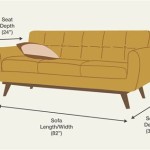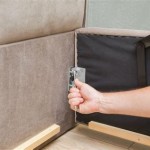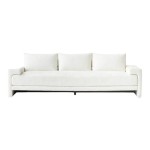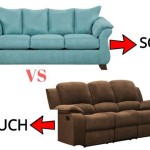How to Set Up a Sofa Bed
Sofa beds offer a versatile solution for accommodating guests or maximizing space in smaller living environments. However, the process of transforming a sofa into a bed, and vice versa, can sometimes seem complex. This article provides a comprehensive guide to setting up a sofa bed, covering different types of mechanisms and offering practical tips for a smooth and efficient conversion.
Before initiating the setup, the initial step involves identifying the type of mechanism your sofa bed employs. Common mechanisms include pull-out, click-clack, and folding models. Understanding the specific mechanism inherent to your sofa bed is crucial for avoiding damage and ensuring proper operation. The manufacturer's instructions, typically provided with the sofa bed, should be consulted for detailed guidance specific to the model.
Understanding Different Sofa Bed Mechanisms
The type of sofa bed mechanism dictates the specific steps required for setup. Familiarizing oneself with the common types is essential for effective operation.
Pull-Out Mechanism: This is perhaps the most prevalent type. It features a bed frame that is concealed within the sofa's structure and is pulled outwards to form the sleeping surface. These often involve a metal frame housing a mattress, which may be folded in multiple sections. Typically, the cushions of the sofa are removed to allow for the bed to be extended.
Click-Clack Mechanism: Also known as futon-style sofa beds, click-clack models transform into a bed by reclining the backrest. A distinct 'click-clack' sound is usually heard as the backrest is lowered into a flat position. The seat and backrest then form a continuous sleeping surface. These models often lack a separate mattress and rely on the sofa's cushioning for comfort.
Folding Mechanism: Some sofa beds utilize a folding mechanism where the entire sofa unfolds to create a bed. This type can be more complex, potentially involving multiple hinges and locking mechanisms. These models may require careful unfolding and securing to ensure a stable and level sleeping surface.
Other Mechanisms: Variations exist, incorporating elements of the above or unique design features. For instance, some sofa beds may incorporate a rotating mechanism or a hidden storage compartment. Always refer to the manufacturer's manual for specific instructions.
Step-by-Step Guide to Setting Up a Pull-Out Sofa Bed
The following steps outline the procedure for setting up a pull-out sofa bed, the most common type.
Step 1: Preparation. Begin by removing all cushions and any decorative items from the sofa. This clears the path for the bed mechanism and prevents damage to the cushions or the sofa frame. Store the cushions in a safe location, such as a closet or under the bed (if space permits), to keep them clean and out of the way.
Step 2: Locating the Release Mechanism. Identify the handle or lever that releases the bed frame. This is commonly located at the front of the sofa, often hidden under the seat cushions. Some models may have a pull strap or a push-button release. Refer to the manufacturer's instructions if unsure.
Step 3: Pulling Out the Bed Frame. Once the release mechanism is activated, gently pull the bed frame outwards. Ensure the frame moves smoothly and without excessive force. If resistance is encountered, check for any obstructions or misaligned parts. Some models may require unfolding certain sections of the frame as it is pulled out.
Step 4: Unfolding the Mattress. The mattress is typically folded in multiple sections within the frame. Unfold each section carefully, ensuring that it lies flat on the bed frame. Some mattresses may have securing straps that need to be unfastened. Inspect the mattress for any damage or wear and tear before use.
Step 5: Securing the Bed Frame (if applicable). Some pull-out sofa beds have locking mechanisms that need to be engaged to secure the bed frame in the open position. This ensures stability and prevents the bed from collapsing. Check the frame for latches, pins, or other securing devices, and engage them according to the manufacturer's instructions.
Step 6: Making the Bed. Once the bed frame is fully extended and secured, proceed to make the bed with sheets, blankets, pillows, and other bedding. Ensure that the bedding is properly fitted and comfortable for use.
Step 7: Reversing the Process. To return the sofa bed to its sofa configuration, reverse the above steps. Start by removing the bedding and folding the mattress back into its original configuration. Then, carefully push the bed frame back into the sofa, ensuring it locks securely in place. Replace the cushions and decorative items to complete the transformation.
Troubleshooting Common Issues
Despite following the instructions carefully, certain issues may arise during the setup process. The following troubleshooting tips can help resolve common problems.
Stuck Mechanism: If the bed frame is difficult to pull out or push in, check for obstructions such as loose objects, tangled bedding, or misaligned parts. A small amount of lubricant, such as WD-40, can be applied to the moving parts to ease friction. Avoid using excessive force, as this can damage the mechanism.
Unstable Bed Frame: An unstable bed frame can be caused by a loose or damaged locking mechanism, uneven flooring, or a bent frame. Ensure that all locking mechanisms are properly engaged. Place shims under the legs of the frame to level it on uneven surfaces. If the frame is bent or damaged, it may require professional repair.
Uncomfortable Mattress: Sofa bed mattresses are often thinner than traditional mattresses and may not provide the same level of comfort. Consider adding a mattress topper to improve comfort and support. A memory foam topper can significantly enhance the sleeping experience. Alternatively, consider replacing the existing mattress with a higher-quality alternative.
Damaged Fabric or Frame: Inspect the sofa bed regularly for any signs of wear and tear, such as rips in the fabric or cracks in the frame. Address any damage promptly to prevent it from worsening. Repair or replace damaged parts as needed to maintain the sofa bed's functionality and appearance.
Noise Issues: Squeaking or creaking sounds can be caused by friction between moving parts. Apply lubricant to the hinges and joints to reduce noise. Tighten any loose screws or bolts that may be contributing to the noise. Regular maintenance and lubrication can help prevent noise issues.
Maintaining a sofa bed requires periodic care to ensure its longevity and optimal performance. Regular cleaning, proper storage of bedding, and prompt attention to any mechanical issues are key aspects of sofa bed maintenance. By following these guidelines, the sofa bed can serve as a reliable and comfortable sleeping solution for years.
Proper maintenance also extends to the fabric covering the sofa bed. Regular vacuuming can remove dust and debris, preventing the buildup of allergens and maintaining the fabric's appearance. Spills should be cleaned immediately to prevent staining. Professional cleaning may be required for stubborn stains or to refresh the fabric's overall appearance.
When the sofa bed is not in use, storing it in the sofa configuration is recommended. This protects the mattress and frame from dust, dirt, and potential damage. Ensure that the bed frame is securely locked in place and that the cushions are properly positioned to maintain the sofa's shape and appearance.
The selection of bedding for a sofa bed is also an important consideration. Opt for lightweight and breathable materials that provide comfort without adding excessive bulk. Fitted sheets designed specifically for sofa bed mattresses are available and can provide a snug and secure fit. Consider using a mattress protector to shield the mattress from spills and stains.
In conclusion, setting up a sofa bed is a straightforward process when approached with an understanding of the specific mechanism involved. By following the step-by-step guides, troubleshooting common issues, and maintaining the sofa bed properly, users can ensure a smooth and comfortable experience. Familiarizing oneself with the manufacturer's instructions is crucial for optimal performance and longevity of the sofa bed.
Proper ventilation around the sofa bed is also important, particularly when it is in the bed configuration. Ensure that there is adequate airflow to prevent moisture buildup and potential mold growth. Avoid placing the sofa bed in damp or poorly ventilated areas. Consider using a dehumidifier if necessary to maintain a dry and comfortable environment.
Finally, remember that safety is paramount when operating a sofa bed. Avoid overloading the bed frame or mattress with excessive weight. Supervise children when they are using the sofa bed to prevent accidents. If any mechanical issues arise, refrain from attempting to repair the sofa bed without proper knowledge and tools. Seek professional assistance if necessary to ensure safe and effective repairs.

3 Simple Ways To Open A Sofa Bed Wikihow

How To Open A Sofa Bed Tips Tricks Living Spaces

3 Simple Ways To Open A Sofa Bed Wikihow

Move Set Up A Sofa Bed Quickly Easily Spaze

How To Use Sofa Beds Syndey Furniture Direct

How To Open A Sofa Bed Tips Tricks Living Spaces

3 Simple Ways To Open A Sofa Bed Wikihow

How To Open A Sofa Bed Spaze

How To Make A Sofa For The Wall Bed System Tiny Apartment Build Ep 6

3 Simple Ways To Open A Sofa Bed Wikihow








